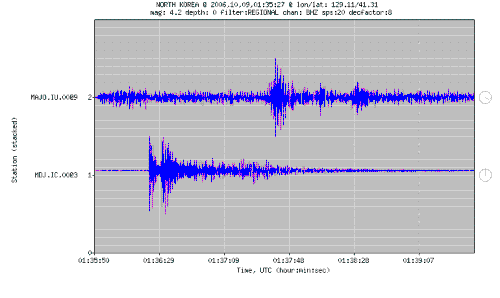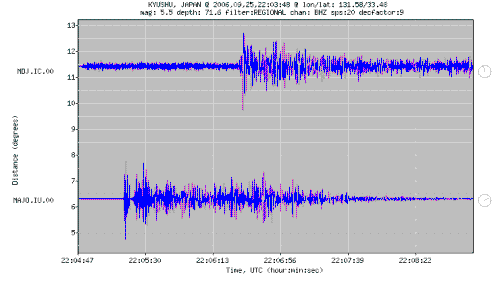See also my update
Lab Lemming asks whether seismology can say anything useful regarding North Korea’s nuclear test. You’d certainly hope so, as monitoring of the Comprehensive Test Ban treaty relies upon it. An earthquake, where rock slides along a fault plane, generates both compressional (P) and shear (S) waves (but generally more of the latter), and patterns of compressional and dilational first motions in the P waves (which are the basis of the beach ball-like focal mechanisms I’ve discussed previously). Explosions basically just push the rock outwards in all directions, producing lots of P waves, not many S waves and a focal mechanism which looks like a big solid circle.
The USGS has confirmed that they detected a seismic event, magnitude 4.2 , which appears to correspond to the test, but they have yet to generate a focal solution (they don’t usually bother for events smaller than about magnitude 5, probably because the signal received at distant stations is too weak to reliably measure first motions). However, the Western Geologist has dug up some seismograph data from here, which I’m just going to lazily reproduce: the first graph is the North Korea event, the second is a recent earthquake for comparison (each line represents one station, which are different distances away, hence the time difference).

P waves are faster than S-waves, so will be the first to reach the station. It seems that for the North Korea event, a lot of the seismic energy received is in the first 10-15 seconds, and the signal dies out quite quickly after that. In contrast, the signal for the Japanese earthquake is received for more than 2 minutes, and the first peak is much less pronounced, suggesting that more energy is arriving in the form of slower S waves, and significant (above background) vibrations are received for a much longer period.
So, it seems likely that this is indeed an explosion, although that says nothing about whether the device actually worked; that would depend on knowing what the intended yield was, and even then it’s tricky, because not all of the energy released will be converted to seismic waves. This uncertainty may be behind the large discrepencies between the various estimates of the size of the explosion reported by New Scientist (see also the discussion at No Se Nada), which has led to speculation that the bomb might have ‘fizzled’. For what it’s worth, one of the textbooks on my desk says that a Hiroshima-size device (10-15 kT TNT equivalent) should generate a magnitude 5 quake, so if it didn’t fizzle, it seems to have been quite a small nuke.
10 October, 2006
North Korean nuclear test
Posted by
Chris R
at
4:17 pm
![]()
Labels: earthquakes, geology, nuclear
Subscribe to:
Post Comments (Atom)




No comments:
Post a Comment